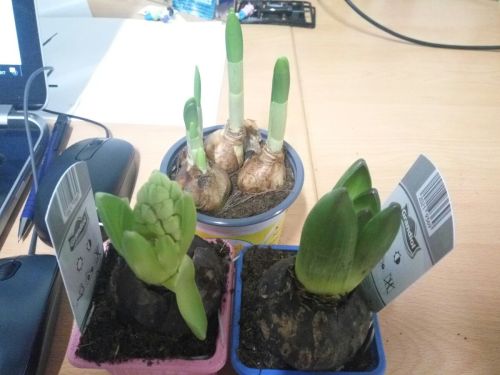#saintpaulia
19/Jan/2017
The amaryllis opened the 5th flower! Sadly the other ones are beginning to wrinkle, but it still looks super pretty. Most of the autumnal bulbs I planted around the 1st of November sprouted already and are doing fine, I changed their place in the greenhouse so they get more sunlight.
Today there was a sale of small flowers and bulbs in a nearby market, I bought african violets, pink chrisanthemums (I gave one to mum for her office), a pink kalanchoe, blue and pink hyacints and narcissus.
Post link

For many of us, African violets (Saintpaulia spp.) are some of the first houseplants we learned how to grow. They are not true violets (Violaceae), of course, but rather members of the family Gesneriaceae. Nonetheless, their compact rosettes of fuzzy leaves coupled with regular sprays of colorful flowers has made them a multi-million dollar staple of the horticultural industry. Unfortunately their numbers in captivity overshadow a bleak future for this genus in the wild. Many African violets are teetering on the brink of extinction.
The genus Saintpaulia is endemic to a small portion of east Africa, with a majority of species being found growing at various elevations throughout the Eastern Arc Mountains of Kenya and Tanzania. Most of the plants we grow at home are clones and hybrids of two species, S. ionanthaandS. confusa. Collected in 1892, these two species were originally thought to be the same species, S. ionantha, until a prominent horticulturist noted that there are distinct differences in the seed capsules each produced. Since the 1890’s, more species have been discovered.

Exactly how many species comprise this genus is still up for some debate. Numbers range from as many as 20 to as few as 6. Much of the early work on describing various Saintpaulia species involved detailed descriptions of the density and direction of hairs on the leaves. More recent genetic work considers some of these early delineations to be tenuous at best, however, even these modern techniques have resolved surprisingly little when it comes to a species concept within this group.

Though it can be risky to try and make generalizations about an entire genus, there are some commonalities when it comes to the habitats these plants prefer. Saintpaulia grow at a variety of elevations but most can be found growing on rocky outcrops. Most of them prefer growing in the shaded forest understory, hence they do so well in our (often) poorly lit homes. Their affinity for growing on rocks means that many species are most at home growing on rocks and cliffs near streams and waterfalls. The distribution of most Saintpaulia species is quite limited, with most only known from a small region of forest or even a single mountain. Its their limited geographic distribution that is cause for concern.

Regardless of how many species there are, one fact is certain - many Saintpaulia risk extinction if nothing is done to save them. Again, populations of Saintpaulia species are often extremely isolated. Though more recent surveys have revealed that a handful of lowland species are more widespread than previously thought, mid to highland species are nonetheless quite restricted in their distribution. Habitat loss is the #1 threat facing Saintpaulia. Logging, both legal and illegal, and farming are causing the diverse tropical forests of eastern Africa to shrink more and more each year. As these forests disappear, so do Saintpaulia and all of the other organisms that call them home.
There is hope to be had though. The governments of Kenya and Tanzania have recognized that too much is being lost as their forests disappear. Stronger regulations on logging and farming have been put into place, however, enforcement continues to be an issue. Luckily for some Saintpaulia species, the type localities from which they were described are now located within protected areas. Protection coupled with inaccessibility may be exactly what some of these species need to survive. Also, thanks to the ease in which Saintpaulia are grown, ex situ conservation is proving to be a viable and valuable option for conserving at least some of the genetic legacy of this genus.

It is so ironic to me that these plants can be so common in our homes and offices and yet so rare in the wild. Despite their popularity, few recognize the plight of this genus. My hope is that, in reading this, many of you will think about what you can do to protect the legacy of plants like these and so many others. Our planet and the species that call it home are doomed without habitat in which to live and reproduce. This is why land conservation is an absolute must. Consider donating to a land conservation organization today. Here are two worth your consideration:

Experimenting With Plants
Idk if this is controversial or not, and I have no idea if it will work for you. I’m just saying what I did when I wanted my African violet to bloom again.
They say to keep the soil evenly moist, but I’ve also read that stress can encourage blooming. So I took a shot in the dark and started letting it dry out. I never water until it’s bone dry.
I like the results so far; I hope they last.

One of the very few plants I take the time to bottom water. Happy Halloween, btw!

Rob’s Gundaroo - I just love all Ralph Robinson’s hybrids. His trailing African violets can’t be beat as far as profuse bloomers go. I must see if anyone in the violet groups has any more leaves to trade. I do have another one of his semi-miniature varieties, Rob’s Combustible Pigeon, though. It’s a young plant that hasn’t bloomed for me yet, but I love it’s variegation.







